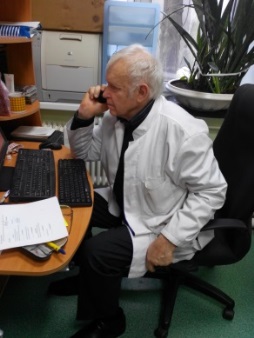
Head of the Division - Tatyana A. Tupoleva, Doctor of Medical Sciences
The division includes:
· the Department for the Infectious Safety of Transfusions
The Division of Virology originates from the Laboratory of Bacteriology and Prevention of Viral Hepatitis and AIDS. From 1965 to 1997, the laboratory was headed by Doctor of Medical Sciences, Professor, Tatyana V. Golosova (20.06.1925—28.09.2020), a student of the outstanding Soviet microbiologist and epidemiologist, the creator of antibiotics in the USSR Zinaida V. Yermolyeva. Under the strict guidance of Tatyana Golosova, the laboratory participated in the development and widespread introduction into medical practice of immune preparations from human blood for the specific prevention and treatment of staphylococcal infections, botulism, and viral hepatitis.
Tatyana Golosova and her team took an active part in the development of measures to ensure the viral safety of blood transfusions and the study of infectious processes of bacterial and viral etiology in hematological and surgical patients and patients with burn disease. Her team developed algorithms for the correction of dysbacteriosis with biological preparations and schemes for diagnosing and preventing viral hepatitis and AIDS in blood service institutions.
1960s, working with bacterial cultures
Under the leadership of Tatyana Golosova, new sensitive methods for detecting markers of viral infections were developed and implemented in blood services throughout the country. First, the method of counterimmunoelectrophoresis (CIEP) to detect the so–called Australian antigen (hepatitis B virus surface antigen – HBsAg), then the passive hemagglutination reaction (RPGA), later the method of enzyme immunoassay (ELISA, modern version – immunochemiluminescent analysis - IHLA) were successfully implemented in blood service institutions thanks to the efforts and irrepressible energy of Golosova.
For the first time in Russia, ELISA test systems were introduced to determine HIV infection, including in blood donors, and medical staff were trained. HIV-seropositive samples were verified from all blood transfusion stations in the country at the laboratory (before the creation of AIDS centers). Donors were tested for antibodies to HIV not only at the NMRC for Hematology, but also at other institutions in Moscow (Bakulev, N.N. Priorov Central Research Institute of Traumatology and Orthopedics, Herzen, etc.).
All the scientific experience accumulated by the laboratory has been introduced into routine practice at the National Medical Research Center for Hematology.
Tatyana V. Golosova is the author of more than 200 scientific papers, 7 monographs, 10 copyright certificates, 8 methodological recommendations, and many laboratory and technical regulations.
Under her leadership, 24 candidate and 2 doctoral dissertations were completed and defended.
The journal "New in Transfusiology" was also published under her leadership.
She is a laureate of the USSR State Prize (1984), awarded the medals "Veteran of Labor,” "For Valiant Labor,” silver and bronze medals at the Exhibition of Achievements of the National Economy, "Inventor of the USSR", and badge "Excellent Health Worker.”
In 1997 the laboratory was divided into two independent divisions: the Laboratory of Clinical Bacteriology, Mycology and Antibiotic Therapy and the Laboratory of Clinical and Virological Diagnosis of Hepatitis and AIDS. The head of the latter and successor of the virological teachings of Golosova , became Felix P. Filatov, world-class expert in the field of herpes virology, Doctor of Biological Sciences.
Felix Filatov was a WHO expert on the development of genetically engineered hepatitis B vaccines based on the smallpox vaccine and yeast vectors. In 1977 he became a visiting professor at the University of Chicago. He worked in the Laboratory of Oncovirology under the direction of Bernard Roizman, as well as at the Gustave Roussy Institute in Paris (headed by P. Sheldrick) on the problem of molecular biology of the herpes simplex virus.
Filatov was a member of the Global Virus Network (Chairman of the network Robert Gallo). He is the author of more than 140 scientific papers, several methodological recommendations, two books devoted to one of the versions of the origin of life on Earth, reasoned by the formal features of the genetic code. He led the laboratory from 1997 to 2013
In 2013 the laboratory was reorganized into the Scientific/Clinical Division of Virological Diagnostics (headed by Tatyana A. Tupoleva, Doctor of Medical Sciences), which includes the Department of Blood Control for Viral Hepatitis, AIDS, Syphilis (head - Anna A. Gulyaeva) and the scientific Laboratory for the Viral safety of Blood Transfusions and its Components (head —Tatiana A. Garanzha, Candidate of Biological Sciences).
The division successfully performs scientific and practical tasks related to improving the infectious safety of donated blood, improving the diagnosis of viral infections in hematological patients and is engaged in training the younger generation of residents and graduate students of hematologists and transfusiologists in the field of viral pathology.
In 2022, the Division of Virological Diagnostics was renamed the Division of Virology.
The division:
- develops measures to preserve public health and ensure timely detection of acute and latent forms of viral infections: HIV infection, viral hepatitis, herpesvirus infections and others
- conducts scientific research in the field of transfusiology, virology, molecular biology and immunology
- develops and implements the latest approaches, methods and technologies for virus testing; automation and optimization of laboratory screening of viral infections
- studies mono- and combined viral infections in patients with secondary immunodeficiency (patients with diseases of the blood system) against the background of the use of new and standard types of therapy





